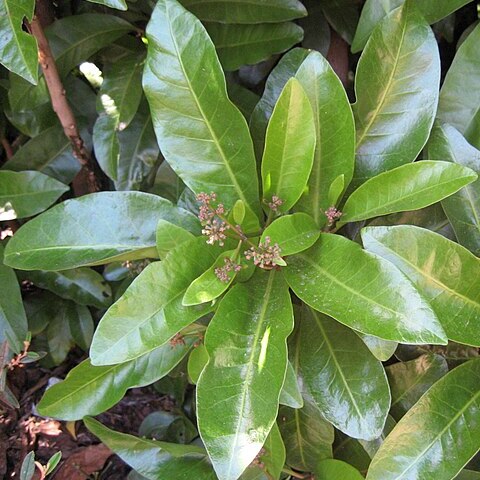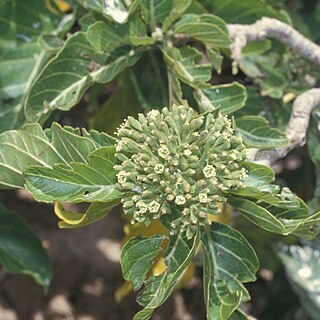Trees and shrubs, sometimes scrambling vines, often armed; young branches pubescent, soon becoming glabrous; spines, when present, axillary and/or produced at tip of a patent branch. Leaves opposite or subopposite, petiolate, entire, glabrous or pubescent. Inflorescences axillary or terminal, sessile or pedunculate, few-to many-flowered, paniculate or corymbiform cymes, sometimes umbelliform or thyrsiform, often borne on modified short shoots. Flowers unisexual, dioecious, exinvolucrate; sessile or pedicellate, 2-3-bracteolate, bracteoles often spirally arranged around the pedicel. Male perianth turbinate or obconic-campanulate, with 5-toothed limb, teeth induplicate-valvate; stamens 6-8(-10), exserted, filaments filiform, connate at base, basifixed or dorsifixed, pollen tricolpate; ovary rudimentary. Female perianth tubular to narrowly campanulate or urceolate, with 5-toothed limb; staminodes present, almost as long as ovary or reduced to a disc; style filiform, slightly longer than perianth, stigma fimbriate, ovule basal, anacampylotropous. Anthocarps dry or fleshy, ellipsoid, oblongoid, obovoid or clavate, with accrescent perianth, terete and costate or 5-angled or-ribbed, with viscid stipitate glands in 1-2(-more) rows along costae, angles or ribs, glands with secretive stalk, head not secretive; seed adherent to pericarp, with deep longitudinal furrow, testa hyaline, embryo straight, cotyledons involute, endosperm scanty, perisperm abundant, mealy, radicle short, inferior.
Shrubs, trees, or scandent woody climbers, perennial, usually pubescent (roots unknown, probably woody). Stems erect, arched, or drooping, unarmed or armed with very sharp, often paired, axillary spines, without glutinous bands on internodes. Leaves petiolate, equal or of unequal size in each pair; blade thin or thick and fleshy, base symmetric or nearly so. Inflorescences axillary and terminal, pedunculate, diffuse or congested, compound corymbiform or cymose; bracts persistent, 2-3 beneath each flower. Flowers unisexual (plants dioecious), chasmogamous; perianth radially symmetric, limb 5-dentate; perianth of staminate flower broadly or narrowly campanulate or urceolate, narrow tube abruptly expanding to limb, limb often reflexed at maturity; perianth of pistillate flower tubular, not constricted beyond ovary, but ultimately closing over it, upper part persisting as 5 small lobes at tip of fruit; stamens 2-many, exserted; styles short exserted; stigmas penicillate. Fruit oblong to clavate, with 5 rounded or angulate ribs, coriaceous, pubescent or glabrate, ribs bearing 1 or more rows of stalked, sticky glands.
Shrubs or small trees, usually scandent and armed with stout axillary spines in our species. Leaves opposite to irregularly approximate. Inflorescences usually terminal on highly modified short shoots, umbelliform or densely corymbiform-thyrsiform. Flowers small, the subtending bracteoles in a more or less contracted spiral upon the pedicel. Staminate flowers campanulate; stamens usually 6-8, unequal, widely exserted, the short tube of the filaments adnate to the stipe of the pistillode. Pistillate flowers tubular, the limb of the perianth apparently always erect, the staminodes reduced to a low, occasionally glandular-dentate disc adnate to the stipe of the pistillode. Anthocarps pentagonal-clavate, coriaceous, armed with longitudinal rows of stipitate glands upon the angles.
Shrubs or trees without spines, or climbers with spines, monoecious or dioecious, mostly glabrescent. Leaves opposite, alternate, sometimes crowded towards ends of twigs. Inflorescences axillary or terminal. Flowers bisexual or unisexual. Perianth campanulate, urceolate or funnel-shaped, 5-, rarely 10-lobed, the upper part coloured, often caducous. Stamens 2–20, mostly exserted. Style longer than ovary; stigma capitate, lobed or fimbriate. Fruit smooth or ribbed; ribs 5 or 6, often glandular-viscid, sometimes the glands developing into viscid prickle-like glandular hairs. See also Du Puy & Telford (1993: 99–100), Green (1994: 75–76).
Shrubs, trees, or vines. Stems sometimes armed. Leaves opposite or alternate, petiolate, margin entire. Inflorescences axillary (or terminal), many-flowered cymes or panicles; bracts absent or inconspicuous, caducous. Flowers unisexual (plant dioecious), bisexual, or polygamous; bracteoles 2-4. Male perianth limb campanulate or funnelform. Stamens 6-10. Female perianth ovate-tubular or cylindric, 5-10-lobed. Ovary sessile, oblique. Stigma capitate or lobed. Fruit oblong or clavate, ribbed, with sticky glands. Seed oblong, with a deep longitudinal furrow; embryo straight, cotyledons recurved, enclosing the endosperm.


